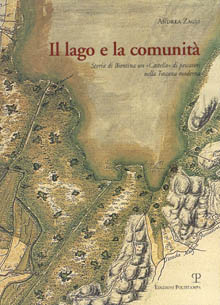Ricerca Veloce
Ricerca Avanzata
chiudi
Andrea Zagli tells the story of a community and its marshland. There are many things in this story: the demographic dynamics of the population, the network of local elites, the
Andrea Zagli tells the story of a community and its marshland. There are many things in this story: the demographic dynamics of the population, the network of local elites, the economic uses and ownership of environmental resources, and the international relationships between two regional States in modern Tuscany. Maybe for this reason Il lago e la comunit� could be interesting for environmental historians. It is interesting not only because the author writes about a lake or about the fishery: the major interest is the connection among all these aspects. Population, government, and economies are linked with the lake environment.
What is the story? The Bientina Lake was a lake-swamp situated across the border between the states of Florence and Lucca. Hunting, fishing and gathering were the economic activities of this area (besides, obviously, some agriculture). The complexity of the environment, adapted to different uses and also to different visions (from the lake as a resource for the fishermen to the lake as an obstacle for the farmers), had many consequences in its history. First of all, there were conflicts among the different users of the swampy area--and in many cases, the reason of the conflict was to some degree ecological. For instance, problems about the kinds of nets used by different groups of fishermen were created by the ecological consequences of each; therefore, some technological options threatened both the ecological and the social equilibrium. Many historians have studied the problem of the ecological impact of different fishing technologies in order to explain the root of the conflict among groups of fishermen. Obviously, the environmental history goes together with the socio-economic history because the problem is to understand why there have been so many different technologies employed by groups of users who were not far distant from each other. In our case, the fishermen from Bientina were fishermen only, while the others from Lucca were not so specialized--i.e., they were fishermen occasionally, while they also had other employment. Thus, we can understand why those from Lucca used forbidden nets more than the inhabitants of Bientina. Another big problem about the fishery rights was the network of water ways in the lake which was very important both for men and for fishes. Opening or closing a canal could generate many disputes. In the background is the question of common property, the theoretical universe of the community and equally the methodological approach for understanding this story. Zagli analyzes the forms of access to the common resources (based on the rule of citizenship, i.e., to belong to the community), explaining at the end of the book the resistance of the community to the change from a common property regime to a private property one.
This is a very beautiful book, a good exemplum of the possibilities for environmental history as total history that can explain not only the environment of a particular area, but in general the socio-economic dynamics of an area, from the point of view of the relationship between environment and society.
Data recensione: 26/09/2007
Testata Giornalistica: Humanities and Social Sciences
Autore: ––
